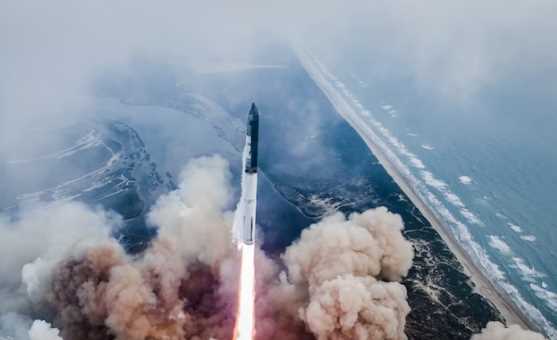
Starship launched World's Biggest Rocket for third time
During its third test flight on Thursday morning, SpaceX's massive Super Heavy-Starship rocket—the most powerful ever constructed—successfully launched the unpiloted upper stage into orbit. Although the two stages failed during independent descents that ended in ocean splashdowns, the flight was praised by business executives as a significant advancement.

Highlights
- SpaceX's Super Heavy-Starship rocket launched the upper stage into orbit but experienced descent failures.
- Live footage captured intense re-entry heating and eventual disintegration.
- Business praise followed the flight, despite the FAA announcing an inquiry into the mishap.
The red light of re-entry heating was seen in spectacular live footage captured from a camera fixed on one of the Starship's fins as the spaceship descended back into the lower atmosphere. The red glow intensified until the Starship was completely engulfed in a dazzling blaze. Its belly's insulation tiles reached temperatures above 2,500 degrees.
At around 40 miles above the surface, telemetry halted, indicating that the Starship disintegrated before it could make a disastrous splashdown, which occurred in the Indian Ocean using rockets. However, the business considered it a significant achievement because they had made it all the way from launch to space and then sufficiently deep into the atmosphere to reach peak heating.
"It's been an incredible day," a SpaceX analyst said.
That being said, the FAA said in a post on X that the loss of both stages was a "mishap" and that it "is going to supervise the SpaceX-led mishap inquiry."
With a thunderous boom, the test flight commenced at 9:25 a.m. EDT as the massive rocket's 33 Raptor engines ignited, consuming 40,000 pounds of liquid oxygen and methane propellants every second.
A second later, the 397-foot-tall rocket started to ascend through the sky, slicing through massive clouds of steam and dust created by the hot exhaust of the booster, vaporizing torrents of water poured upward from the pad's base to lessen the shock of engine ignition.
As the Super Heavy-Starship smoothly accelerated, it lost weight and consumed propellants. It then traveled away to the east into the Gulf of Mexico, entertaining thousands of locals, visitors, and a horde of journalists coming from the launching site and close by South Padre Island with a breathtaking display.
As the rocket shot over the area of highest aerodynamic stress and out of the dense lower atmosphere, all 33 Raptors seemed to fire normally. The rocket also went faster than sound.
Upon liftoff, the Raptors started their scheduled shutdown two minutes and forty-two seconds later. Shortly after, the Starship upper stage's six engines were ignited while the booster remained connected, a recent addition called "hot staging." The Extremely Heavy and Starship stage split cleanly a minute later.


